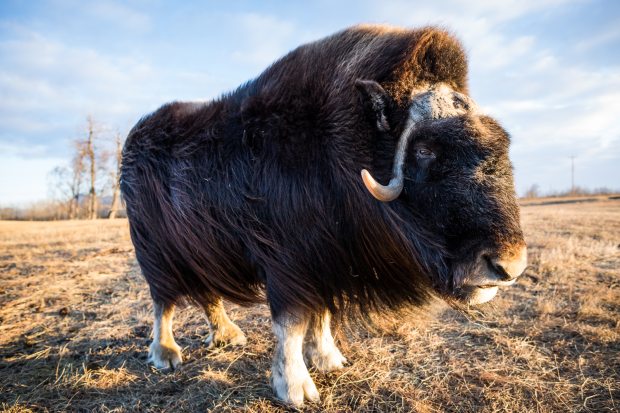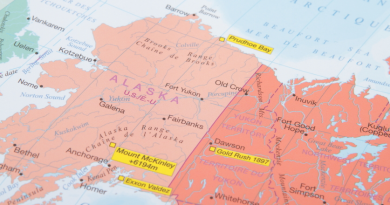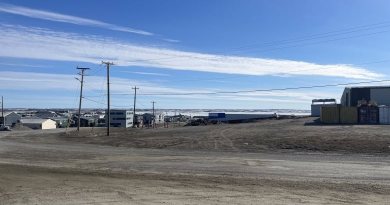Muskoxen on the move in Northwest Alaska

(Loren Holmes / Alaska Dispatch)
In 2009, researchers attached 121 radio-tracking collars to adult female muskoxen in Northwest Alaska, part of an in-depth study intended to track muskox behavior and lifestyles in some of the Last Frontier’s harshest environments.
Those collars were programmed to fall off on June 1 of this year, and researchers have already revealed one surprising result: Over the course of the four years, many of the collared muskoxen traveled hundreds of miles, flying in the face of previous perceptions of the animals as stationary throughout much of their lives.
“That’s just not a normal kind of thing to see in an animal that’s usually viewed as very sedentary,” said Layne Adams, a research wildlife biologist with the U.S. Geological Survey.
The muskox, a prehistoric mammal that resembles a furrier bison and which at first glance appears to have a placid, meandering personality, had disappeared from Alaska by the 1920s in much the same way they died off earlier in mainland Europe and Asia. In 1930, 34 muskox were delivered to Fairbanks in hopes of restoring the species in North America’s far north. Soon, those 34 muskox turned into a herd of more than 750 after being transplanted to Nunivak Island in the Bering Sea, and the population was redistributed again to Northeast Alaska and the Seward Peninsula, among other locations.
The most recent study focused on two of those populations, one in the Cape Thompson area, ranging from the mouth of the Noatak River north to the western North Slope. The other population occupied a portion of the Bering Land Bridge National Preserve, with some of the population on the Seward Peninsula.
“Since the early ’70s, the two populations have grown at different rates,” Adams said. “What we’re doing is working on a baseline study to look at the building blocks of the population dynamics” between the two distinct groups.
Of the 121 collared animals, 75 were fitted with standard radio collars, which could only be monitored via aircraft overflights of the herds. The other 46 animals were fitted with more-advanced GPS tracking collars, which provided a constant stream of data — updated every four hours — upon which researchers could draw when it came time to track the animals’ movements.
Those movements were unexpected.
One 567-pound female, fitted with a GPS collar, traveled from the Seward Peninsula’s northwest coast, to an area south of Shishmaref, then to Wales, before finally arriving near the community of Brevig Mission in summer of 2013. Between the point where she was captured and Wales, the animal traveled approximately 150 miles as the crow flies, though a map of the muskox’s whereabouts shows a lot more detail about various detours that greatly increased the actual distance traveled over those four years.
In particular, she covered lots of ground in the summers of 2009 and 2012, according to a post documenting the muskox movements at the National Park Service web page.
“The thing that was really kind of surprising,” Adams said, “was that our study focused on radio-collaring adult females, and those are the animals you kind of expect to move around the least.”
Research upends broader population dynamics study
Researchers would expect those females to be even less mobile than males, given the muskox’s annual birth cycles. Females more than 2 years old typically give birth to a single calf in the spring following the fall mating season, meaning they’ll have a young calf with them much of the summer. Then, in the winter, muskoxen tend to be less mobile, partially as an energy-conservation technique, during the harsh Arctic Alaska winters and partially out of physiological necessity.
“They’re somewhat restricted,” Adams said. “They’ve got short little legs. They don’t move around too well in the snow.”
The wide range of the animals throws an early kink into the researchers’ plans for a larger study on population dynamics, given that the muskox are now known to move around considerably more than previously thought.
Much remains unknown about muskox behavior in Alaska, given the species’ history in the state, along with the remote locations and harsh environments in which the animals live.
“I think there’s a lot we don’t know about them compared to the other large hoofed animals in Alaska or northern North America,” Adams said. “I think they’ve been studied much less here than anywhere else. They tend to live in places that are hard to work in … we certainly found that to be true.”
Previous studies of muskox have focused on flyovers of various herds, which researchers now know may be an unreliable way to observe populations, given that muskox are more mobile than formerly thought.
Muskox, which normally congregate in groups of 20-25 but can gather in herds of 60 or more animals, were thought to have a single home range throughout their lifespan. But, Adams said, that one female that was the focus of the recent post at the NPS, actually had three distinct home ranges over the course of the four-year study.
Given the scattered observations of flyovers, paired with the lack of on-the-ground observation, populations that scientists thought were one group of animals may be another group entirely. And to make matters worse, muskoxen move around between herds with some regularity.
“You tend to find musk ox in the same places over and over and over again, and you kind of build the assumption that these are the same animals that you saw … a month ago in that in that same location,” Adams said.
The researchers are planning to continue to drill down on additional data gained during the lengthy study of the two muskox populations, Adams said, but these initial findings are interesting enough to merit their own paper — given how it debunks preconceived notions about Alaska muskoxen.
Contact Ben Anderson at ben(at)alaskadispatch.com



